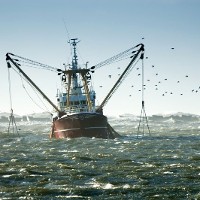Analyzing fisheries-induced evolution
Pressure from large-scale commercial fishing, and intense recreational and sport fishing, is accelerating evolution in some fish populations and threatening the sustainability of fisheries. IIASA research on exploitation-induced evolution has assembled evidence that human exploitation not only changes the abundance of targeted fish populations over time, but also alters their heritable traits. Exploited fish populations worldwide are tending to start reproducing at an earlier age and smaller size. In some populations this reduces fish biomass; in others it increases resilience to fishing. In either case, fisheriesinduced evolution changes a stock’s productivitiy, stability to collapse, and recovery potential.
International collaboration
IIASA and an international network of collaborating experts are analyzing the major causes of fisheries-induced evolution, including its ecological and socioeconomic consequences. The work, which includes development of models for strategic and tactical evaluations of
exploited fish stocks, is coordinated through the Working Group on Fisheries-Induced Evolution (WGEVO) of the International Council for the Exploration of the Sea (ICES), co-chaired by IIASA scientists. Work covers the Barents Sea adjacent to Norway and Russia, the North Sea and Baltic Sea, an Austrian mountain lake, the coastal seas of China, waters off Iceland,
Newfoundland, and New England, and rivers in Alaska and Québec.
In recent years, IIASA research has been broadened through the European Marie Curie Research Training Networks ModLife (Modern Life History and Its Application to the Management of Natural Resources) and FishACE (Fisheries-induced Adaptive Change in Exploited Stocks) and the European Union-funded Specific Targeted Research Project FinE (Fisheries-induced Evolution).
Impacts
- The groundbreaking IIASA work on fisheries-induced evolution has attracted the close attention of policy bodies like ICES, the main advisory agency for managing the North Atlantic Ocean and adjacent seas. The extension by ICES of the WGEVO expert group for a second three-year term is an endorsement that would have been inconceivable a decade ago.
- IIASA is pioneering the development of Evolutionary Impact Assessments (EvoIAs) to allow fisheries managers to assess the evolutionary status of fish populations they oversee. In particular, IIASA has driven the development of an EvoIA for North Sea plaice, the first of its kind, published in 2012. Another new framework will identify fisheries management options that are acceptable to diverse stakeholders, including commercial and recreational fishers, fisheries managers, policymakers, businesses, and the public. The ultimate goal is to produce a “traffic light” indicator system for communicating the evolutionary vulnerability of commercially exploited fish stocks.
- IIASA has led research into the economic repercussions of fisheriesinduced evolution which shows that genetic changes induced by fishing can sometimes be beneficial when fish populations are exploited with restraint, whereas with heavy exploitation, predominant worldwide, fisheries-induced evolution tends to reduce yields and revenues.
- The EU Marine Strategy Framework Directive uses the method developed at IIASA to help disentangle genetic and phenotypically plastic changes in fish life histories. The method has been incorporated into the Data Collection Framework Regulation: the 2009 Commission Decision C (2009) 10121 on “the collection, management and use of data in the fisheries sector” explicitly specifies “size at maturation of exploited fish species” as an “indicator of the potential ‘genetic effects’ on a population.” The IIASA method has also been incorporated into the 2010 Commission Decision C(2010) 5956 on “criteria and methodological standards on good environmental status of marine waters.”

CONTACT DETAILS
Principal Research Scholar Exploratory Modeling of Human-natural Systems Research Group - Advancing Systems Analysis Program
Principal Research Scholar Systemic Risk and Resilience Research Group - Advancing Systems Analysis Program
Principal Research Scholar Cooperation and Transformative Governance Research Group - Advancing Systems Analysis Program
Analyzing Fisheries-induced Evolution (PDF)


